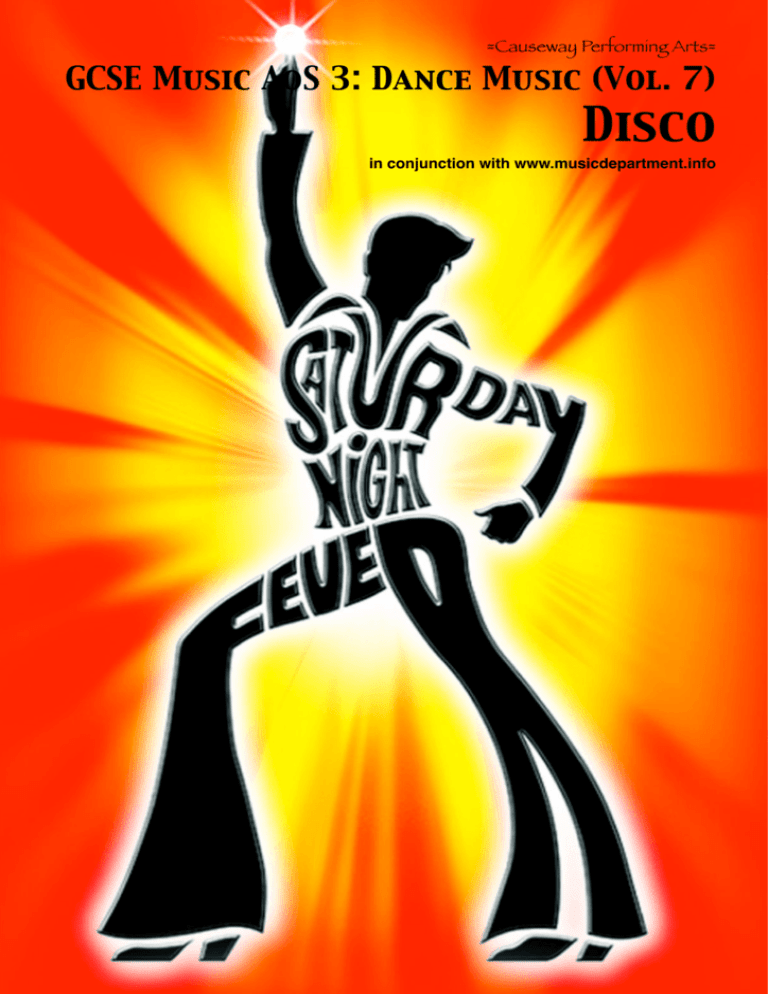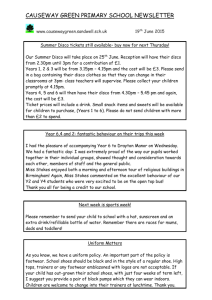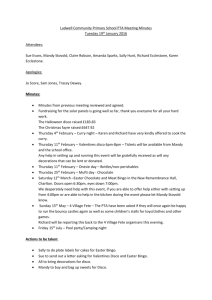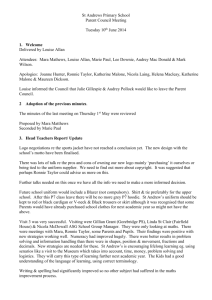GCSE Music AoS 3: Dance Music (Vol. 7)
advertisement

=Causeway Performing Arts= GCSE Music AoS 3: Dance Music (Vol. 7) Disco in conjunction with www.musicdepartment.info DISCO BACKGROUND The first discotheques originated in France during World War II. Discotheques are nightclubs or venues in which recorded rather than live music is played. In Paris during the 1930s and 40s, before the war started, jazz clubs with live bands were popular venues for dancing. However, during World War II the Germans banned jazz music because of its Jewish and black associations. Live jazz performances became impractical and dangerous, so venue owners continued to make an illicit living by playing records instead. The idea of the disc jockey (or DJ) emerged - this was the person who made the announcements and played the records. In the 1960s the concept of the discotheque was introduced to America and it quickly became popular. It was much cheaper for a club owner to hire a DJ to play up-to-date records, rather than hire a live band whose music might be unvaried and behind the times. In the 1960s DJs would throw together all types of music for their dancers, such as jazz, rock, soul and blues. In the early 1970s music started to appear that was specifically written for the discotheques in New York, creating a new genre of disco music. One of the first disco records is thought to be Soul Makossa by Manu Dibango, released in 1972. An important figure in the early development of disco music is the record producer Tom Moulton. In order to keep people on the dance floor, he extended the length of a disco song from 3 minutes to between 5 and 7 minutes, with the technique called remixing. A remix is a new version of the original song. It mixes up elements of the original recording and combines them with new material. In Tom Moultonʼs case, he extended the original songs by looping sections of them. Tom Moulton was also partly responsible for the creation of the 12 inch single, which could hold more music and the 7 inch single. Cities such as New York had dance schools and instructors that taught people how to do popular disco dances. One of these dances was The Hustle, originally a line dance that developed in New York and Florida in the 1970s. It became really popular after the release of Van McCoys song The Hustle in 1975. A ʻcouple versionʼ of the dance - commonly known as the New York or Latin hustle - then took over after it was depicted in the 1977 film Saturday Night Fever. But also combine steps from swing and salsa dancing. Popular disco singers and groups include the Bee Gees, Donna summer, Gloria Gainer, Village People, and the Jackson Five. What does the dance look like? • • • Disco dance can be done in one spot on the dance floor- there is no particular need to travel very far around the room. Dances wave and move their arms around a lot in disco dance. Disco dances such as the Hustle have specific steps and routines. In fact the hustle has developed into a type of ballroom dance that is commonly performed in dance competitions around the world. • Disco dancing can also be individual and improvised. A dancer can move on to the dance floor and perform their own basic, or more complex moves, simply dancing in a disco style. MUSICAL CHARACTERISTICS Features common to most disco music include: • • • • • • • • • • • • A time signature of ò, with a steady crotchet beat. This is often emphasised by the bass drum, which will play a constant, pumping crotchet rhythm. An accent on the second and fourth beat in each bar. These beats are usually emphasised by the percussion section, in particular the snare drum. Towards the end of the 1970s handclaps became common on the second and fourth beats. A constant quaver or semiquaver rhythm played on a high-hat. This rhythm sometimes become syncopated for variation. The same semiquaver rhythm on the guitar, its sound distorted by the use of Wahwah pedals. An electric piano to fill out the harmony, playing repeated chords . Steady tempo of around 120 beats per minute. Catchy vocal melody. Reverb is often added to the voice. Backing vocals, especially in the chorus are commonly ʻmulti-trackedʼ to create harmony. A verse-and-chorus structure that commonly includes the following: an introduction (often slower than the rest of the song) ✓ verses (for each verse that she remains the same but the live exchange) ✓ choruses with a hook lines (repetitive phrases with a narrow range of notes) ✓ a middle eight, which can be a new instrumental or vocal section ✓ A fade out at the end of the song (giving the DJ an opportunity to mix the end of ✓ the song with the beginning of the next one) Regular four-bar phrases. A full orchestral sound, often with strings and brass instrument that soar above the melody or play during the breaks. A sustained strings sound is common to much disco music. The use of synthesised sounds, especially in the late 1970s and onwards. For an example of a popular disco song, listen to blame it on the boogie by the Jackson five. Opening with a strong bass riff, you can immediately hear the drum pattern that is characteristic of disco music. The bass drum plays on every beat, there are quavers in a high-hat part, and hand claps on beats 2 and 4. After the Introduction of the song follows a typical verse-and-chorus structure. There are frequent brass frills and stabbing chords. The backing vocals in the chorus add harmony to the vocal line. The rich, orchestrated sound is typical of much disco music. You can also hear that there is a fadeout at the end of the song.



